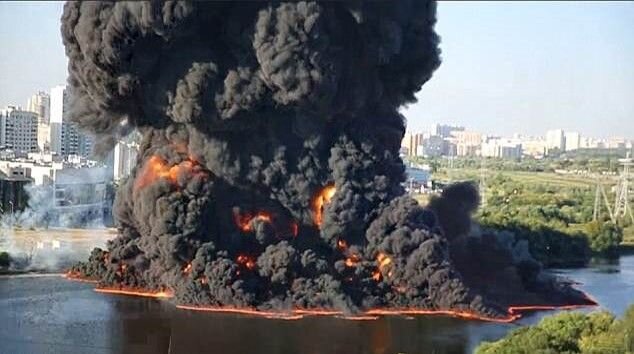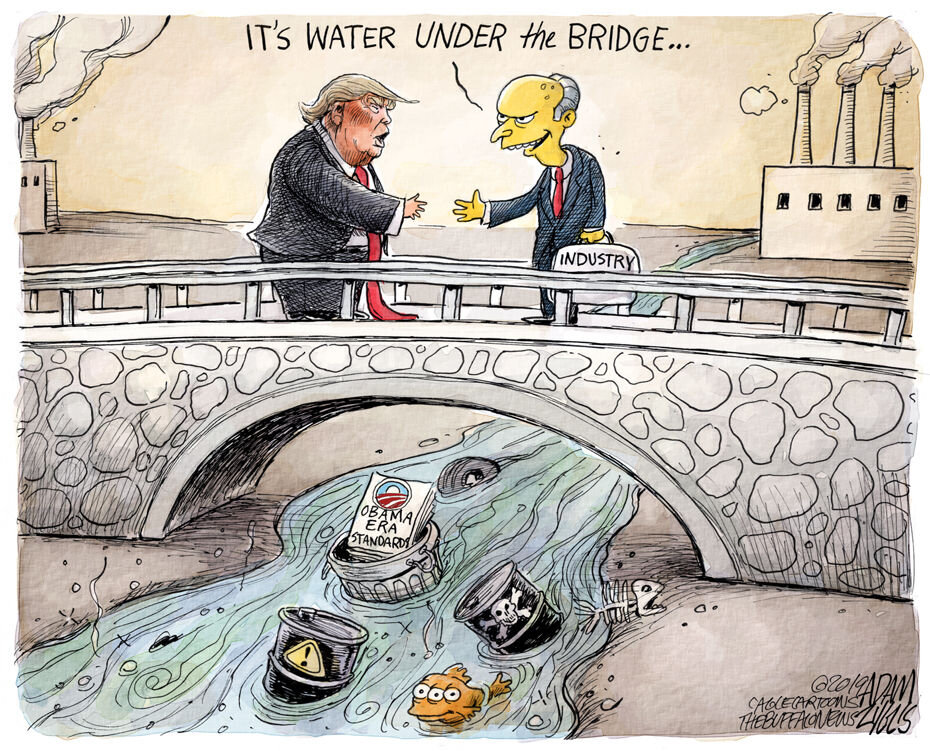Generations of Water Policy Trumped-Up
By Jimi T Hardee, Rachel Major, & Ari Ochoa
When we think of Cleveland Ohio the first thing that comes to mind is probably the Rock and Roll Hall of Fame or the opening of the Drew Carey show. Within the cultural imagination of the layperson, the city is a pleasant enough metropolis in middle America. However, there is a dark chapter of the history of Cleveland that would eventually become a rallying point for modern environmental reform. In 1969, a spark from nearby train tracks spread to the considerable amount of industrial waste floating from Lake Erie into the Cuyahoga river and set the water ablaze; flames rose out of the Cuyahoga, reaching as high as 50 feet in just a few minutes. The blaze was put out quickly before much damage was caused, but from its ashes was born an American environmentalist movement that finally started getting serious about proper government regulation to preveese scenes of horror.
The 1960s and 1970s were marked with a series of environmental disasters not unlike this river fire. Public concern rose over the nuclear testing at Bikini Atoll, oil spills off the coast of California, and, of course, Rachel Carson’s “Silent Spring” warning about DDT killing our Bald Eagles. In fact, the 1969 incident was not the first time that the Cuyahoga had caught fire. Between the end of the Civil War and the 1950s, the river was set ablaze 9 times, with one fire in 1952 causing millions of dollars in property damage. The history of pollution was so bad that one of the city’s mayors called the river “an open sewer through the center of the city” because of all the unchecked industrial pollution in its waterways. This would all change, though, after 1969; people were starting to think about the out-of-control pollution running rampant in our country. Though many different events were starting to shift the public’s image on environmental regulation - or lack thereof - the mass public outcry over the Cuyahoga fire is credited by many to be the spark that eventually led to the formation of the Environmental Protection Agency (EPA), the Clean Water Act (CWA), and a myriad of other reforms in the past 50 years.
Photo of Cuyahoga river fire, 1969
It may sound like the Cuyahoga fire of ‘69 marked the beginning of a golden era of environmentalism in the US. However, considering the decades of harrowing disasters the American public had to wade through to start seeing actual regulation, it also serves as a stark warning - change doesn’t come easy, even when it’s in our best interest. This warning is especially dire considering that for the past 4 years environmental policy generations in the making have been under attack by the robust deregulation campaigns of the Trump administration. This type of vast deregulation has never before been seen in the United States. If Trump’s war on the environment continues, events like the Cuyahoga fire may once again be commonplace, so we will be examining a few of these critical rollbacks with a focus on water.
The Clean Water Act (CWA) of 1972 was in many ways the beginning of sensible water regulations in the United States. The CWA essentially established the basis of all modern water pollution regulations in the US. Even the history behind this policy is a testament to the slow wheels of government - The first major piece of legislation that regulated water pollution was passed in 1948, but was meant to be little more than a placeholder until a more robust policy could be enacted. It took 24 years for the CWA to finally be written into law with several amendments in the last half century. In fact, the CWA was originally vetoed by then-president Nixon, a decision which had to be overridden by congress to see this policy finally come to fruition. Over its lifespan, the CWA has seen the inception of a host of new clean water regulations and the bill itself has been amended several times. Laws change from administration to administration but overall the CWA has gotten stricter with each new revision, until now.
Adam Zyglis cartoon, The Buffalo News
While the CWA itself is not under direct threat from the Trump administration, the president has not hesitated to attack many of the regulations that have been introduced under the Clean Water Act’s umbrella. The most publicized of these attacks is a rollback of a 2015 “Waters of the United States” (WOTUS) rule that extended the authority of the EPA to prevent companies or individuals from polluting wetlands and tributaries of waterways. This is important because up until that point, creeks and streams that were dry for part of the year, as well as wetlands close to rivers were largely unregulated. Trump’s rollback of the WOTUS rule means that, once again, people and corporations will be largely free to pollute US waterways.
The president is not alone in his crusade for deregulation, as the Republican controlled senate has also played their role in reversing water protections. In 2017 the Senate reversed a regulation from 2016, the “Stream Protection Rule” which prevented mining companies from dumping debris in streams. Mining can be an extremely invasive process, especially in terms of water contamination. Debris from coal mines can contain sulfates, heavy metals, arsenic, and other things you likely don’t want in your water. The GOP has characterized this rollback as a measure to revitalize the American coal industry, but does the cost of doing business have to be the loss of our health and our world?
Photo from 2017 Trump rally. Saul Loeb | AFP | Getty Images
It would be impossible to go into every example of the Trump administration’s rollbacks of environmental policy in this piece, even if we only focused on water. The changes and proposed changes range from aggravating, such as the withdrawal of a proposed rule to reduce air pollution at sewage treatment plants, to downright super villainous, such as the withdrawal of a proposal to protect groundwater from uranium contamination. For a more complete list of Trump’s war on the environment there is a pretty good article from the New York Times here. Suffice it to say this: water is only a small part of the picture. The unprecedented environmental deregulation we are seeing here extends to air pollution, drilling and extraction, infrastructure planning… pretty much anything you can think of.
List of Trump’s rollbacks.
To be clear, President Trump is not the first president (nor will he be the last) who has rolled back environmental protections. Still, this is deregulation on a scale we haven’t really seen since the EPA was created, and it is unlikely to slow down as long as Trump remains in the White House. The big problem here is time, with a sympathetic congress deregulation can happen extremely quickly, as we’ve seen in the last four years. Regulation on the other hand is a long and drawn out process even if congress is agreeable. Even beyond the immediate threat of global climate catastrophe, the impact of environmental deregulation threatens the lives and livelihoods of all Americans. It should be straightforward to say that without clean air, clean water, and nutritious food people get sick, property gets destroyed, and businesses lose money.
Despite all this, a concerning number of Americans don’t seem to be bothered by these regressive policy reforms. So what can be done, and why aren’t people doing more? The answer to both of these questions comes down to politics. As with many things in our country, the future of environmentalism will be decided in the voting booth, and unfortunately, many people in the United States have become compelled (knowingly or not) to vote against their own interests. In our next piece we will be exploring the politicization of the environment and how we as citizens can fight against deregulation.





